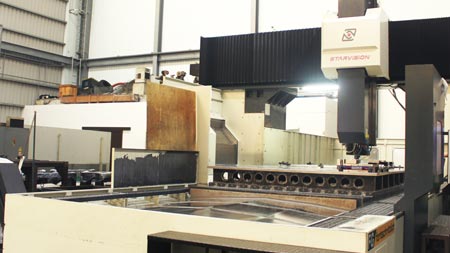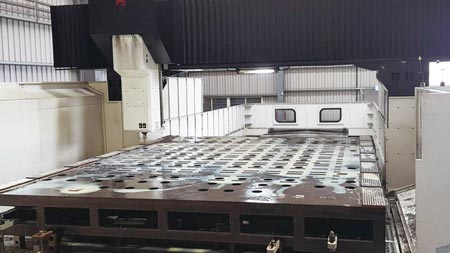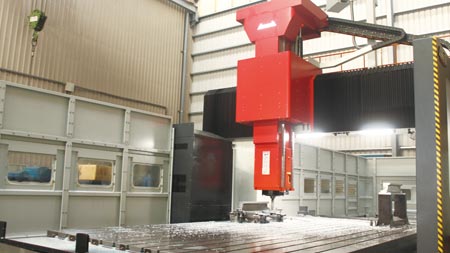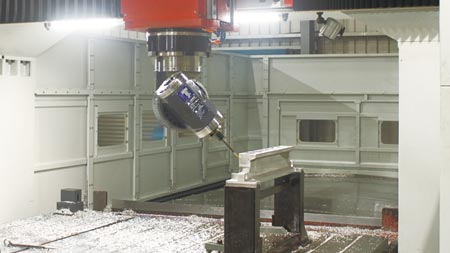Five-axis gantry machining






Five-axis gantry machining technology represents a breakthrough in the field of high-precision machining. It combines the flexibility of five-axis CNC machining with the stability of gantry machining centers, providing advanced solutions for various high-demand machining needs. This technology not only enhances machining precision and efficiency but also extends machining capabilities, especially suited for complex shapes and multi-faceted machining requirements.
Principles of Five-Axis Gantry Machining
The five-axis gantry machining center integrates the robust structure of gantry systems with the flexible motion of five-axis machining, including:
• X and Y Axes:These are the primary movement axes of the gantry machining center, controlling the horizontal and vertical movements of the machine bed.
• Z Axis:Perpendicular to the X-Y plane, this axis controls the up-and-down movement of the tool relative to the workpiece.
• A and B Axes:These axes allow the tool to rotate, enabling angular machining of the workpiece. The A-axis typically rotates around the X-axis, and the B-axis around the Y-axis, allowing machining in five directions.
This five-axis control system enables complex machining operations in a single setup, reducing the need for re-clamping of the workpiece and improving machining precision.
Key Advantages of Five-Axis Gantry Machining
• Precision and Stability:
Due to the inherent structural stability of the gantry machining center combined with the precise control of five-axis machining, machining accuracy can reach micron levels, suitable for high-precision component manufacturing.
• Complex Geometry Machining:
Five-axis gantry machining centers can cut in multiple angles and directions, making the machining of complex shapes feasible, such as inclined surfaces, curved surfaces, and intricate internal structures.
• High-Efficiency Production:
Five-axis machining can complete multiple machining steps in one setup, significantly reducing the time spent on re-clamping and repositioning, thus enhancing overall production efficiency.
• Reduced Tool Change Frequency:
The ability to perform multi-angle machining reduces the frequency of tool changes, further increasing machining speed and efficiency.
Applications of Five-Axis Gantry Machining
• Aerospace:
In the aerospace industry, five-axis gantry machining is used to manufacture complex mechanical structure components such as engine parts and fuselage components, meeting the rigorous requirements of aerospace precision and stability.
• Automotive Manufacturing:
In the automotive sector, five-axis gantry machining is used to produce engine parts, chassis components, and other high-performance parts, improving precision and efficiency in automotive manufacturing.
• Medical Devices:
The production of medical devices often requires extreme precision. Five-axis gantry machining can produce complex and fine medical device components, such as surgical tools and implants.
• Mold Manufacturing:
Five-axis gantry machining technology is crucial in mold manufacturing, capable of producing high-precision molds for injection molding, die casting, and other processes.
Five-axis gantry machining technology represents the trend of high-precision machining in modern manufacturing. It combines the stability of gantry machining centers with the flexibility of five-axis machining, providing advanced solutions for complex and high-demand machining requirements. This technology not only enhances precision and production efficiency but also expands machining capabilities, making it a key technology for achieving high-performance and high-precision manufacturing.
Five-axis gantry machining is an advanced CNC machining technology that has become a core technique in modern manufacturing due to its high precision and efficiency. Whether for small-batch custom production or large-scale automated manufacturing, five-axis gantry machining meets the diverse needs of various industries. Weisheng Industrial offers precise machining solutions with state-of-the-art five-axis gantry machining and laser cutting equipment, capable of handling complex designs and customizing metal products and precision components based on client needs. Additionally, our services include sheet metal processing, frame welding, CNC gantry milling, and automated equipment assembly. Weisheng Industrial is committed to delivering the highest quality machining services, making us a reliable partner in the metal processing field, ensuring that every project meets the highest standards of quality and precision.